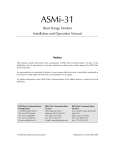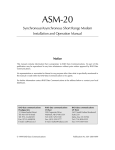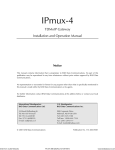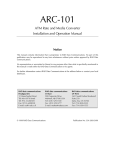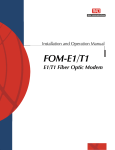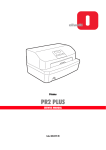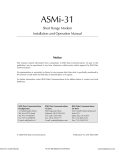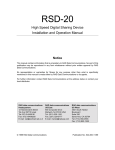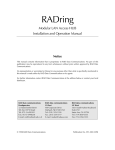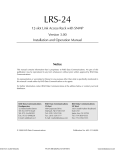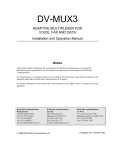Download RAD Data comm FOMi-T1 Specifications
Transcript
FOMi-E1/T1 High Speed Fiber Optic Modem Installation and Operation Manual Notice This manual contains information that is proprietary to RAD Data Communications. No part of this publication may be reproduced in any form whatsoever without prior written approval by RAD Data Communications. No representation or warranties for fitness for any purpose other than what is specifically mentioned in this manual is made either by RAD Data Communications or its agents. For further information contact RAD Data Communications at the address below or contact your local distributor. RAD Data Communications Headquarters 12 Hanechoshet Street Tel Aviv 69710 Israel Tel: 972-3-6458181 Fax: 972-3-6498250 E-mail: [email protected] RAD Data Communications US East 900 Corporate Drive Mahwah, NJ 07430 USA Tel: (201) 529-1100 Fax: (201) 529-5777 E-mail: [email protected] © 2000 RAD Data Communications RAD Data Communications US West 3631 South Harbor Boulevard Suite 250 Santa Ana, CA 92704 Tel: (714) 850-0555 Fax: (714) 850-1555 Publication No. 317-200-01/00 Warranty This RAD product is warranted against defects in material and workmanship for a period of one year from date of shipment. During the warranty period, RAD will, at its option, either repair or replace products which prove to be defective. For warranty service or repair, this product must be returned to a service facility designated by RAD. Buyer shall prepay shipping charges to RAD and RAD shall pay shipping charges to return the product to Buyer. However, Buyer shall pay all shipping charges, duties and taxes for products returned to RAD from another country. Limitation of Warranty The foregoing warranty shall not apply to defects resulting from improper or inadequate maintenance by Buyer, Buyer-supplied firmware or interfacing, unauthorized modification or misuse, operation outside of the environmental specifications for the product, or improper site preparation or maintenance. Exclusive Remedies The remedies provided herein are the Buyer’s sole and exclusive remedies. RAD shall not be liable for any direct, indirect special, incidental, or consequential damages, whether based on contract, tort, or any legal theory. Safety Warnings The exclamation point within a triangle is intended to warn the operator or service personnel of operation and maintenance factors relating to the product and its operating environment which could pose a safety hazard. Always observe standard safety precautions during installation, operation and maintenance of this product. Only a qualified and authorized service personnel should carry out adjustment, maintenance or repairs to this instrument. No adjustment, maintenance or repairs should be performed by either the operator or the user. Laser Warnings This product may be equipped with a laser diode. In such a case, this laser warning symbol label will be attached near the optical transmitter. Please observe the following precautions: • Do not attempt to adjust the laser drive current. • Do not use broken or unterminated fiber-optic cables/connectors or stare at the laser beam. • The use of optical equipment with this product will increase eye hazard. • Use of controls, adjustments or performing procedures other than those specified herein, may result in hazardous radiation exposure. Telecommunication Safety The safety status of each of the ports on the FOMi-E1/T1 is declared according to EN 41003 and is detailed in the table below: Ports Safety Status E1, T1 (electrical) SELV Circuit operating with Safety Extra-Low Voltage Regulatory Information FCC-15 User Information This equipment has been tested and found to comply with the limits of the Class A digital device, pursuant to Part 15 of the FCC rules. These limits are designed to provide reasonable protection against harmful interference when the equipment is operated in a commercial environment. This equipment generates, uses and can radiate radio frequency energy and, if not installed and used in accordance with the instruction manual, may cause harmful interference to the radio communications. Operation of this equipment in a residential area is likely to cause harmful interference in which case the user will be required to correct the interference at his own expense. Warning per EN 55022 This is a Class A product. In a domestic environment, this product may cause radio interference, in which case the user may be required to take adequate measures. Declaration of Conformity Manufacturer’s Name: RAD Data Communications Ltd. Manufacturer’s Address: 12 Hanechoshet St. Tel Aviv 69710 Israel declares that the product: Product Name: FOMi-E1/T1 Conforms to the following standard(s) or other normative document(s): EMC: Safety: EN 55022 (1994) Limits and methods of measurement of radio disturbance characteristics of information technology equipment. EN 50082-1 (1992) Electromagnetic compatibility - Generic immunity standards for residential, commercial and light industry. EN 60950 (1992/93) Safety of information technology equipment, including electrical business equipment. Supplementary Information: The product herewith complies with the requirements of the EMC Directive 89/336/EEC and the Low Voltage Directive 73/23/EEC. The product was tested in a typical configuration. Tel Aviv, November 18th, 1998 Haim Karshen VP Quality European Contact: RAD Data Communications GmbH, Lyoner Strasse 14, 60528 Frankfurt am Main, Germany Quick-Start Guide If you are familiar with fiber optic modems, use this guide to prepare FOMi-E1/T1 for operation. QS.1 Installing FOMi-E1/T1 For most normal installations, setup of FOMi-E1/T1 should be performed in the following order (see Chapters 2 and 3 for details of each procedure): Warning Jumper Setting Setup Configuration via Front Panel Alarms Check Make sure that the AC power cord is disconnected before removing the unit's cover. 1. Remove the internal board. 2. Set Cable Type jumper as required (75Ω unbalanced for E1, 120Ω balanced for E1 or 100Ω balanced for T1) (see section 2.4 for details). 3. Replace the board and close the unit. 1. Install the unit in a rack (optional, see Appendix A for details). 2. Disconnect the cables from the units. 1. Configure modem with remote modem details (see Chapter 3). 2. Connect the units to the DTEs. 3. Configure the DTE parameters. 4. Configure the Line parameters. Make sure that there are no alarms indicated on the LCD. QS.2 Operating FOMi-E1/T1 Connections 1. Connect the fiber optic cables. 2. Connect the power cable. FOMi-E1/T1 is turned on automatically upon connection to a power source. 3. If there is an indication of a malfunction or fault, run the appropriate tests (see Chapter 4). FOMi-E1/T1 Quick Start Guide 1 Quick-Start Guide 2 Operating FOMi-E1/T1 FOMi-E1/T1 Installation & Operation Manual Preface Foreword This manual provides information on the technical characteristics, installation and operating instructions of FOMi-E1/T1. The manual contains the following information: Chapter 1. Introduction Describes the FOMi-E1/T1, the versions available, features and options. Briefly describes the Front Panel, LEDs, jumpers, connectors and fuses. This chapter also provides a basic functional description of the FCD-T1 and a short description of some of the main operations and options. Chapter 2. Installation Explains how to install the FOMi-E1/T1. Explains how to perform all the connections needed to setup the FOMi-E1/T1. Explains how to set the jumpers and switches. Chapter 3. Operation Describes the controls, indicators and functions of the FOMi-E1/T1. Explains how to operate the FOMi-E1/T1. Chapter 4. Troubleshooting Describes the diagnostic tests provided by the FOMi-E1/T1. Explains how to operate the Internal BER Tester and Pattern Generator. Explains the various alarms and real time messages that may be encountered. Outlines trobleshooting procedures. Chapter 5. Sample Application This chapter illustrates the configuration and setup of a typical application of the FOMi-E1/T1. Conventions Note Caution Warning A note draws attention to a general rule for a procedure, or to exceptions to a rule. A caution warns of possible damage to the equipment if a procedure is not followed correctly. A warning alerts to the presence of important operating and maintenance (servicing) instructions in the literature accompanying the equipment. If these instructions are not followed exactly, possible bodily injury may occur. Contents QUICK-START GUIDE QS.1 Installing FOMi-E1/T1......................................................................................................1 Jumper Setting ......................................................................................................................... 1 Setup....................................................................................................................................... 1 Configuration via Front Panel ................................................................................................... 1 Alarms Check........................................................................................................................... 1 QS.2 Operating FOMi-E1/T1....................................................................................................1 Connections ............................................................................................................................ 1 CHAPTER 1. INTRODUCTION 1.1 Overview ....................................................................................................................... 1-1 General Description.............................................................................................................. 1-1 Application ........................................................................................................................... 1-1 Features................................................................................................................................ 1-2 Versions................................................................................................................................ 1-2 1.2 Physical Description ....................................................................................................... 1-3 Front Panel ........................................................................................................................... 1-3 Rear Panel ............................................................................................................................ 1-3 1.3 Functional Description ................................................................................................... 1-4 General ................................................................................................................................ 1-4 Main Principles of Operation ................................................................................................ 1-4 1.4 Technical Specifications ................................................................................................. 1-6 Electrical Interface................................................................................................................. 1-6 Power................................................................................................................................... 1-6 Optical Interface ................................................................................................................... 1-6 Range ................................................................................................................................... 1-6 General Indicators................................................................................................................. 1-7 Diagnostics ........................................................................................................................... 1-7 Controls and Displays............................................................................................................ 1-8 Physical Dimensions ............................................................................................................. 1-8 Environment ......................................................................................................................... 1-8 CHAPTER 2. INSTALLATION & SETUP 2.1 Site Requirements and Prerequisites .............................................................................. 2-1 Power................................................................................................................................... 2-1 Ambient Requirements ......................................................................................................... 2-1 2.2 Package Contents........................................................................................................... 2-1 2.3 Equipment Needed........................................................................................................ 2-2 2.4 Jumper Setting ............................................................................................................... 2-2 Connecting the Interfaces...................................................................................................... 2-3 Connecting the Power........................................................................................................... 2-5 Fuse ..................................................................................................................................... 2-6 2.5 Initial Operation and Basic Checks................................................................................. 2-6 FOMi-E1/T1 Installation and Operation Manual iii Contents Power-On Procedure ............................................................................................................ 2-6 Normal Operating Indications ............................................................................................... 2-6 Power-Off Procedure ............................................................................................................ 2-6 CHAPTER 3. OPERATION 3.1 Controls and Indicators .................................................................................................. 3-1 3.2 Operating Procedures .................................................................................................... 3-3 General Instructions .............................................................................................................. 3-4 Viewing Modem Configuration (STATUS) .............................................................................. 3-5 Viewing Active Alarms (ALARM BUFFER).............................................................................. 3-7 Configuring the Line (LINE CONFIG).................................................................................... 3-7 Configuring the DTE (DTE CONFIG)...................................................................................... 3-8 TESTS ................................................................................................................................... 3-9 CHAPTER 4. TROUBLESHOOTING AND DIAGNOSTICS 4.1 Troubleshooting ............................................................................................................. 4-1 4.2 Status Indicators and Alarms........................................................................................... 4-3 Messages .............................................................................................................................. 4-3 Viewing Active Alarms (ALARM BUFFER)............................................................................... 4-3 Dry Contact Alarms............................................................................................................... 4-4 4.3 Diagnostic Tests ............................................................................................................. 4-5 Local Test - Local Analog Loopback (LLB) .............................................................................. 4-5 Remote Digital Loopback (RLB)............................................................................................. 4-7 Activation by a Remote User ................................................................................................. 4-9 Internal BER Tester and Pattern Generator Operation .......................................................... 4-10 Remote Digital Loopback + BERT....................................................................................... 4-11 LEDS Check........................................................................................................................ 4-12 APPENDIX A. RACK INSTALLATION A.1 Installation of the Unit Case into a 19" Rack................................................................... A-1 General ................................................................................................................................A-1 Installation of a Single Unit....................................................................................................A-1 Installation of Two Units........................................................................................................A-3 iv FOMi-E1/T1 Installation and Operation Manual List of Figures Figure 1-1 Application Diagram .................................................................................................... 1-1 Figure 1-2 FOMi-E1/T1 Simplified Block Diagram.......................................................................... 1-3 Figure 1-3 FOMi-E1/T1 Simplified Block Diagram.......................................................................... 1-5 Figure 2-1 FOMi-E1/T1 Stand Alone PCB Layout ........................................................................... 2-3 Figure 2-2 FOMi-E1/T1 Rear Panel, AC Power Connection............................................................ 2-4 Figure 2-3 FOMi-E1/T1 Rear Panel, DC Power Connection ........................................................... 2-4 Figure 3-1 FOMi-E1/T1 Master Front Panel.................................................................................... 3-1 Figure 3-2 FOMi-E1/T1 Slave Front Panel ...................................................................................... 3-2 Figure 3-3 PCU Front Panel ........................................................................................................... 3-2 Figure 3-4 LCD Data Fields............................................................................................................ 3-3 Figure 3-5 FOMi-E1/T1 Menu Option Menu ................................................................................. 3-5 Figure 3-6 STATUS Menu Options................................................................................................. 3-7 Figure 3-7 LINE CONFIG Menu: Configuring the Remote Modem ................................................ 3-8 Figure 3-8 DTE Config Parameters Configuration ........................................................................... 3-9 Figure 4-1 ALARM BUFFER Menu ................................................................................................. 4-4 Figure 4-2 Local FOMi-E1/T1 in Analog Loopback (LLB) ................................................................ 4-6 Figure 4-3 FOMi-E1/T1 Tests Menu - LLB ...................................................................................... 4-7 Figure 4-4 FOMi-E1/T1 in Remote Digital Loopback (RLB) ............................................................ 4-7 Figure 4-5 FOMi-E1/T1 Tests Menu - RLB...................................................................................... 4-8 Figure 4-6 Activation of LLB at the Remote Modem ...................................................................... 4-9 Figure 4-7 Activation of RLB at the Remote Modem ...................................................................... 4-9 Figure 4-8 FOMi-E1/T1 Internal BER Test .................................................................................... 4-10 Figure 4-9 FOMi-E1/T1 in Remote Digital Loopback + BERT (RLB+BERT).................................. 4-12 Figure A-1 Installation of a Single Unit ........................................................................................... A-2 Figure A-2 Installation of Two Units ............................................................................................... A-3 Figure A-3 Fastening Two Units Together....................................................................................... A-4 FOMi-E1/T1 Installation and Operation Manual v List of Tables List of Tables Table 1-1 Power Coupled into Fiber and Approximate Application Range ..................................... 1-6 Table 2-1 DB-15 Pin Assignment ................................................................................................... 2-5 Table 2-2 FOMi-E1/T1 Indicator Status .......................................................................................... 2-6 Table 3-1 FOMi-E1/T1 Controls and Indicators .............................................................................. 3-3 Table 3-2 Menu Type Options....................................................................................................... 3-5 Table 3-3 STATUS Menu Options.................................................................................................. 3-6 Table 3-4 LINE CONFIG Menu Options ........................................................................................ 3-7 Table 3-5 DTE Config Menu Options............................................................................................. 3-8 Table 4-1 Troubleshooting............................................................................................................. 4-2 Table 4-2 Real Time Messages....................................................................................................... 4-3 Table 4-3 ALARM BUFFER Menu Options ..................................................................................... 4-3 Table 4-4 Major and Minor Alarm Pin Table .................................................................................. 4-4 Table 4-5 TESTS Menu Options..................................................................................................... 4-5 vi FOMi-E1/T1 Installation and Operation Manual Chapter 1 Introduction This chapter: • Describes FOMi-E1/T1, the versions available, features and options. • Briefly describes the Front Panel. • Provides a basic functional description of FOMi-E1/T1 and a short description of some of the main operations and options. • Details FOMi-E1/T1 technical specifications. 1.1 Overview General Description FOMi-E1/T1 is a fiber-optic modem for transmission of E1 (2048 Mbps) and T1 (1544 Mbps) signals over multimode or single-mode fiber-optic media. The unit is transparent to framing, and can transmit data using any framing pattern with HDB3 E1 or B8ZS T1 coded signals. FOMi-E1/T1 supports both E1 and T1 in a single unit. The E1 interface fully complies with the applicable ITU standards and uses HDB3 line coding. The T1 interface fully complies with requirements of ITU G.703 and G.824 standards and uses B8ZS line coding. Application In the application illustrated in Figure 1-1, each FOMi-E1/T1 receives E1 or T1 signals, which are equalized in order to overcome electrical link distortion. FOMi-E1/T1 then converts the E1 or T1 signals into an optical signal. The optical signal is linked to the fiber-optic media, and transmitted via the optical link to the remote unit. A high sensitivity pre-amplifier and an AGC (Automatic Gain Control) circuit enable the remote unit to receive the optical signal. The output of the receiver is applied to the clock recovery and the data re-generation circuit, which in turn applies it to the electrical interface driving circuit. Fiber Optic T1 or E1 Coax PABX FOMi-E1T1 T1 or E1 FOMi-E1T1 Coax DACS Figure 1-1 Application Diagram Overview 1-1 FOMi-E1/T1 Installation & Operation Manual Chapter 1. Introduction Features FOMi-E1/T1 extends the range of E1/T1 signals over fiber optic links. It is available as a standalone unit or as a card version for the LRS-12 19" modem rack with SNMP management. FOMi-E1/T1 supports E1 balanced and unbalanced (coax) interfaces and is transparent to framing. Operating over multimode or single mode fibers, FOMi-E1/T1 has a transmission range up to 100 km using the laser diode option. FOMi-E1/T1 conforms to all relevant ITU standards; diagnostic loops conform to ITU V.54 standard. Full management of local and remote units is available from the front panel. Alarms are indicated in real time, for local and remote units, including dry contact external alarms, on the front panel LCD or on the attachable PCU. FOMi-E1/T1 features a built-in V.52 BER tester. FOMi-E1/T1 is designed to operate with several different grades and sizes of fiber-optic cable, and provides the user with: Versions • Extended range for high-rate transmission • Immunity to electrical interference such as EMI, RFI, spikes and differential ground loops • Secure data transfer (no tapping on the information passed) • Protection from sparking and lightning • A secure link in hazardous or hostile environments. The FOMi-E1/T1 unit is supplied in a compact, standalone case that can either be placed on a desk top/shelf, or mounted in a 19" rack (with adapters). A card version for the LRS-12 manageable rack, which can accommodate up to 12 modem cards, is also available. The modem can be ordered as either master version or slave version. The FOMi-E1/T1 slave version features a proprietary 20-pin connector for connection to the PCU unit. The following ordering options are available: 1-2 • 850 nm multimode • 1300 nm LED for singlemode or multimode fibers • LASER diode for increased range over 1300 nm or 1550 nm singlemode fibers. Physical Description FOMi-E1/T1 Installation & Operation Manual Chapter 1. Introduction 1.2 Physical Description FOMi-E1/T1 is a compact unit, intended for installation on desktops or shelves. The unit height is 4.4 cm (1.7") (see Figure 1-2). Figure 1-2 FOMi-E1/T1 Simplified Block Diagram Front Panel All controls (buttons and LCD) and LED indicators are located on the FOMi-E1/T1 front panel. On the master unit of FOMi-E1/T1 and on the PCU there are three buttons on the front panel – "SCROLL," "CURSOR," and "ENTER." These buttons allow you to work through the menu displayed on the front panel LCD, change the system configuration, or monitor the system status. The front panel of the FOMi-E1/T1 master version and the PCU features an LCD of 2 rows, 16 characters each, which displays the user menu. The slave version features a proprietary 20-pin connector for connection to the PCU unit. See Chapter 3 for details on the function of each button and indicator on the master and slave versions. Rear Panel The rear panel connectors and their uses are described in Chapter 2, Installation. The internal jumpers and preset switches are also described in Chapter 2. Functional Description 1-3 FOMi-E1/T1 Installation & Operation Manual Chapter 1. Introduction 1.3 Functional Description General This section describes the functional circuitry of FOMi-E1/T1 and focuses on the requirements for setting the correct configuration of the modem. See Figure 1-3 for a block diagram of FOMi-E1/T1 circuitry. Main Principles of Operation FOMi-E1/T1 is a high speed data link between computers, routers or multiplexers. FOMi-E1/T1 utilizes a Phase Locked Loop (PLL) circuit to recover jitter-free data and clock from the optical signal. FOMi-E1/T1 converts electrical signals from the DTE unit into an optical signal using an infrared light emitting diode at 850 nm, 1300 nm, or a laser diode at 1300 nm or 1550 nm. At the opposite end of the fiber, the optical signal is converted back into an electrical signal in compliance with the appropriate interface. Electrical Interfaces To recover data and clock from the signal, a Phase Locked Loop (PLL) circuit is utilized. FOMi-E1/T1 provides internal selection for the following electrical interfaces: (E1) 75Ω unbalanced and 120Ω balanced; (T1) 100Ω balanced. When FOMi-E1/T1 detects that the electrical interface levels are below G.703 electrical levels, or if the Bit Error Rate (BER) on the optical interface is higher than 1 x 10-5, the modem transmits an all "1" signal (AIS) to the optical interface. When an all "1" signal (AIS) is detected at the optical or electrical interface, the modem transparently converts the signal and alerts the user via front panel LEDs and the supervisory port. Power Supply The power supply converts from -48 VDC, +24 VDC, 100 VAC, 115/230 VAC input voltage to ±5V output voltage. G.703 Interface The modem has the capability of accepting the following digital interfaces: G.703-E1 (2048 Kbps), or G.703-T1 (1544 Kbps). Fiber Optic Interfaces The modem can accept the following fiber optic interfaces: 1-4 • Infrared LED at 850 nm • Infrared LED at 1300 nm • Laser diode at 1300 nm • Laser diode at 1550 nm in the SC, ST, FC optical connectors. Functional Description FOMi-E1/T1 Installation & Operation Manual Chapter 1. Introduction BERT The pattern generator sends a standard 511-bit pseudo-random pattern to the remote unit when the user activates the modem diagnostic. At the same time, the pattern receiver checks the data received from the remote unit and compares it with the standard 511-bit pattern. If errors are detected, the ERR LED indicator flashes or remains ON. The errors are also displayed on the LCD. Power Supply BERT LCD/PCU and LEDs CPU TX MNG IN Jitter Attenuator Scrambler G.703 Interface AIS Gen. OUT Descrambler AIS Det. CDP Coder RX MNG TX TX Fiber Optic CDP Encoder RX RX PLL Figure 1-3 FOMi-E1/T1 Simplified Block Diagram Technical Specifications 1-5 FOMi-E1/T1 Installation & Operation Manual Chapter 1. Introduction 1.4 Technical Specifications Electrical Interface The electrical interface meets requirements of ITU G.703, G.921 and G.956 standards for E1 and T1. Transmission rates 2.048 Mbps for E1 standards 1.544 Mbps for T1 standards Interface User selectable by means of internal switches: − 75Ω unbalanced E1 − 120Ω balanced for E1 − 100Ω balanced for T1 Zero suppression E1: HDB3 T1: B8ZS Connectors RJ-45 (RJ-48C) for T1 or E1 balanced interfaces Two BNC connectors for E1 unbalanced interface. Power 115V or 230 VAC -48 VDC Optical Interface Operating Wavelength – 850 nm (multimode) – 1300 nm (single-mode) – 1550 nm (single-mode) Connectors ST or FC-PC or SC 50/60 Hz, 20W max. -36 to -72 VDC 20W max. Range Table 1-1 Power Coupled into Fiber and Approximate Application Range Fiber Type 850 nm 1300 nm 1550 nm laser dBm km dBm km dBm km dBm km 9/125 - - -18 45 -12 60 -12 100 62.5/125 -18 5 - - - - - - Receiver sensitivity 1-6 1300 nm laser Technical Specifications For BER: 10-9 38 dBm at 850 nm 40 dBm at 1300 nm 40 dBm for laser 1300 nm 40 dBm for laser 1550 nm FOMi-E1/T1 Installation & Operation Manual General Indicators Diagnostics Chapter 1. Introduction Dynamic range 28 dB for all types of optical interfaces Budget (Max) 20 dB for 850 nm over 62.5/125 22 dB for 1300 nm over 9/125 28 dB for 1300 nm laser over 9/125 POWER (green) On when the unit is powered. ELECTRICAL LOW (red) On when the electrical interface input is below G.703 electrical levels. ELECTRICAL AIS (yellow) On when an all "1" string is received at the electrical interface. OPTICAL ERR (red) On when Bit Error Rate of the received signal from the optical interface is 10-6 or worse. OPTICAL AIS (yellow) On when an all "1" string is received at the optical interface. TEST (red) On when a test is active at the local or the remote unit. ERR (red) On when an alarm condition is initiated, or blinking when an error is detected in the data stream. Local (LLB) Analog loopback, activated from the front panel, from a PCU, or from the remote unit. Remote (RLB) Digital loopback, through the remote modem and remote DTE, activated from the front panel, from the PCU, or from the remote unit. Remote + BERT A remote digital loopback with internal BER tester. BERT Built-in pattern generator and tests, activated from the front panel, from the PCU, or from the remote unit. Performs BER test over the link. LED Check LEDs test, activated from the front panel or the PCU. Technical Specifications 1-7 FOMi-E1/T1 Installation & Operation Manual Chapter 1. Introduction Controls and Displays LCD Two rows of 16 characters (Master Unit) Buttons CURSOR, SCROLL, ENTER (Master and PCU units) Indicators See Section 3.1 Physical Dimensions Environment 1-8 Height Width Depth Weight Operating Temperature Humidity Technical Specifications 4.4 24 19.3 1.4 cm cm cm kg / 1.7 in (1U) / 9.6 in / 7.6 in / 3.1 lb 0-50°C /32-122°F Up to 90%, non-condensing Chapter 2 Installation & Setup This chapter provides mechanical and electrical installation procedures for FOMi-E1/T1. If a problem is encountered, refer to Chapter 4 for troubleshooting instructions. FOMi-E1/T1 is supplied as a fully assembled standalone unit. FOMi-E1/T1 can be adapted to fit into a 19" rack (to order the rack mount adapter kit, see Ordering Options on the FOMi-E1/T1 data sheet). See Appendix A for rack mount adapter installation instructions. 2.1 Site Requirements and Prerequisites Power AC-powered FOMi-E1/T1 units should be installed within 1.5m (5 ft) of an easily accessible, grounded AC outlet capable of furnishing the required supply voltage of the unit (115 or 230 VAC). DC-powered FOMi-E1/T1 units require a -48 VDC power source which must be adequately isolated from the mains supply. In order to prevent a fire hazard, the (negative) supply line must contain a suitable fuse or a circuit breaker. Ambient Requirements The ambient operating temperature of FOMi-E1/T1 is 0–50oC (32–122oF) at a relative humidity of up to 90%, non-condensing. Allow at least 90 cm (36 in) of frontal clearance for operating and maintenance accessibility. Allow at least 10 cm (4 in) clearance at the rear of the unit for signal lines and interface cables. 2.2 Package Contents The package of the FOMi-E1/T1 standalone unit includes: • FOMi-E1/T1 modem (protected by adequate cushioning) • AC power cord or DC power supply connector kit • FOMi-E1/T1 Installation and Operation Manual Package Contents 2-1 Chapter 2. Installation & Setup FOMi-E1/T1 Installation & Operation Manual 2.3 Equipment Needed To operate the standalone version of the FOMi-E1/T1 modem on a desktop or shelf, no additional equipment is needed. To install the standalone version of the FOMi-E1/T1 modem in a 19" rack (either single or in a side by side configuration when a couple is needed), a rack adapter kit, RM-9, is required (for rack installation instructions refer to Appendix A). 2.4 Jumper Setting Access to the inside of the equipment is permitted only to authorized and qualified service personnel. Warning To avoid accidental electric shock, always disconnect the interface cables and the power cord before removing the unit from its casing. Line voltages are present inside FOMi-E1/T1 when it is connected to power and/or to the lines. Moreover, under external fault conditions dangerous voltages may appear on the lines connected to the unit. Any adjustment, maintenance, and repair of the opened instrument under voltage should be avoided as much as possible and, when inevitable, should be carried out only by a skilled technician who is aware of the hazard involved. Capacitors inside the instrument may remain charged even after the instrument has been disconnected from its power supply source. ➤ To open the FOMi-E1/T1 case: 1. Disconnect the power cord from the mains outlet. 2. Release the two rear panel screws and use them as levers to slide the PCB interior out of the unit. ➤ To set the jumpers: 1. Identify the jumper according to the configuration diagram (see Figure 2-2). 2. Set the cable type jumper as required: E1 unbalanced (75Ω) E1 balanced (120Ω) T1 balanced (100Ω) (230 VAC and -48 VDC options are factory preset to E1 (120); 115 VAC is factory preset to T1.) 2-2 Jumper Setting FOMi-E1/T1 Installation & Operation Manual Chapter 2. Installation & Setup 120 E1 100 T1 75 E1 Cable Type Jumper Figure 2-1 FOMi-E1/T1 Stand Alone PCB Layout ➤ To return FOMi-E1/T1 to its case: 1. Insert the board firmly into the FOMi-E1/T1 case. 2. Insert the FOMi-E1/T1 top cover by pushing it straight down. 3. Insert and tighten the four cover screws. Connecting the Interfaces Figures 2-3 and 2-4 show the rear panel of a standard version FOMi-E1/T1 unit and identify connector locations for the AC and DC versions, respectively. Jumper Setting 2-3 Chapter 2. Installation & Setup FOMi-E1/T1 Installation & Operation Manual Figure 2-2 FOMi-E1/T1 Rear Panel, AC Power Connection Figure 2-3 FOMi-E1/T1 Rear Panel, DC Power Connection Connecting the Fiber-Optic Cables Two fiber-optic SC, ST or FC-PC connectors are located on the rear panel and marked TX and RX. ➤ To connect the fiber-optic cables: 1. Remove the protective caps from the connectors and store them in a safe place for later use. 2. Connect the transmit fiber to the connector of the central unit marked TX and the receive fiber to the connector marked RX. 3. At the remote unit connect the transmit fiber to RX and the receive fiber to TX. Connecting the Electrical Cable The E1, balanced link and T1-link connections are connected via an RJ-45 connector, or two BNC connectors for E1, unbalanced link. The BNC connectors are designed as OUT and IN. OUT refers to a signal transmitted from the FOMi-E1/T1 to the attached equipment. IN refers to the FOMi-E1/T1 input signal. The RJ-45 pin connector is used for connection of T1 (see Tables 2-1). 2-4 Jumper Setting FOMi-E1/T1 Installation & Operation Manual Chapter 2. Installation & Setup Table 2-1 RJ-45 Pin Assignment Pin No. Designation/ Function 1 TTIP 2 TRING 3 Frame Ground 4 RTIP 5 RRING 6 Frame Ground 7, 8 Not connected The E1 and T1 ports should be connected to SELV (Safety Extra Low Voltage) links only. Warning Dry Contact Alarm The supervisory port is a 9-pin, D-type connector which provides dry contact for major and minor alarms. For more information and pinout, see Chapter 4, Table 4-4. Connecting the Power To connect the power to FOMi-E1/T1, refer to the appropriate section below, depending on your version of the unit (DC or AC). Warning The unit has no power switch. Operation starts when power is applied to the rear panel POWER connector. When applying power, first connect the plug of the power cord to the FOMi-E1/T1 POWER connector and then to the mains power source (outlet). Before switching on this instrument, connect the protective earth terminals of this instrument to the protective conductor of the (mains) Grounding power cord. Insert the mains plug only into a socket outlet with a protective earth contact. Only use an extension cord (power cord) with a protective conductor (grounding). Replace fuses only with fuses of the same current and voltage rating as indicated on the unit. Do not short-circuit fuse holders. Whenever it is likely that the protection offered by fuses has been impaired, the instrument must be made inoperative and secured against any unintended operation. For your protection, FOMi-E1/T1 must always be grounded. Any interruption of the protective (grounding) conductor (inside or outside the instrument) or disconnection of the protective earth terminal can render this instrument dangerous. Intentional interruption is prohibited. Jumper Setting 2-5 FOMi-E1/T1 Installation & Operation Manual Chapter 2. Installation & Setup AC Power Connection AC power should be supplied to FOMi-E1/T1 through the 5 ft (1.5m) standard power cable terminated by a standard 3-prong plug (see Figure 2-2). The cable is provided with the unit. ➤ To connect AC power to FOMi-E1/T1: • Connect the power cable to the connector on the FOMi-E1/T1 rear panel and then to the mains outlet. The unit turns on automatically upon connection to the mains. DC Power Connection ➤ To connect DC power to FOMi-E1/T1 • Fuse Refer to DC Power Supply Connection Supplement. The fuse is located in an integral-type fuse holder located on the rear panel (see Figure 2-3) Make sure that only fuses of the required rating, as marked on the FOMi-E1/T1 rear panel, are used for replacement. Do not use repaired fuses or short-circuit the fuse holder. Always disconnect the mains cable before removing or replacing the fuse. If the fuse protection has been damaged, disconnect the unit from the power mains and secure it against unintended operation. 2-6 Jumper Setting FOMi-E1/T1 Installation & Operation Manual Chapter 2. Installation & Setup 2.5 Initial Operation and Basic Checks Power-On Procedure FOMi-E1/T1 is turned on as soon as power is connected. When power is connected, the PWR LED lights up to indicate that the FOMi-E1/T1 is on. When the unit is powered ON, operating personnel are not exposed to voltage in excess of 30 volts on any card or accessible area of the DC power supply. Normal Operating Indications Table 2-1 lists the correct status of the indicators, a few seconds after power-up. Table 2-2 FOMi-E1/T1 Indicator Status Power-Off Procedure Indicator Status PWR ON LCD Display Displays opening screen: “FOMi-E1/T1 REV X.X I N I T I A L I Z I N G...” ERR ON (“SYNC-LOSS” always occurs during power-up) Test OFF FOMi-E1/T1 is turned off by disconnecting its power. Always disconnect the power cord from the mains outlet first. Initial Operation and Basic Checks 2-7 Chapter 2. Installation & Setup 2-8 Initial Operation and Basic Checks FOMi-E1/T1 Installation & Operation Manual Chapter 3 Operation This chapter describes FOMi-E1/T1 front panel controls and indicators and their functions. It also explains how to configure and operate the modem LCD menu. All the installation procedures described in Chapter 2 must be completed and checked out successfully before you attempt to operate FOMi-E1/T1. 3.1 Controls and Indicators All controls and indicators are located on the front panel of FOMi-E1/T1. On the master unit of FOMi-E1/T1 and on the PCU unit, there are three front panel button switches: SCROLL, CURSOR, and ENTER (see Figures 3-1 and 3-3). Using these switches, the user can toggle through the menu displayed on the front panel LCD, change the system configuration, or monitor the system status. Both the front panel of the FOMi-E1/T1 master version and the PCU have an LCD with 2 rows, 16 characters each, for displaying the user’s menu choices. Table 3-1 lists the functions of each switch and indicator on FOMi-E1/T1 master and slave versions and on the PCU. The Item numbers in the table correspond to the call-outs in Figures 3-1, 3-2 and 3-3. 1 2 CURSOR SCROLL PWR ELECTRICAL LOW 5 AIS LOW 6 7 4 3 ENTER OPTICAL TEST ERR FOMi-E1T1 REV X.XX INITIALIZING ... AIS 8 9 10 11 Figure 3-1 FOMi-E1/T1 Master Front Panel Controls and Indicators 3-1 FOMi-E1/T1 Installation and Operation Manual Chapter 3. Operation FOMi-E1T1 PWR ELECTRICAL LOW 5 OPTICAL AIS LOW 7 CONTROL TEST ERR AIS 8 9 11 13 Figure 3-2 FOMi-E1/T1 Slave Front Panel PCU CONTROL UNIT REV X.X FOMi-E1T1 INITIALIZING CURSOR 1 SCROLL ENTER 2 Figure 3-3 PCU Front Panel 3-2 Controls and Indicators 3 FOMi-E1/T1 Installation and Operation Manual Chapter 3. Operation Table 3-1 FOMi-E1/T1 Controls and Indicators Item Name Type Function 1 CURSOR Button Moves the cursor between the LCD fields. 2 SCROLL Button Moves between options of the current menu. 3 ENTER Button Selects the current option and updates both local and remote modem data bases. 4 LCD display LCD display Displays the current menu screen and cursor position. 5 PWR (green) LED indicator On when power is on. 6 ELECTRICAL LOW (red) LED indicator On when electrical interface input is below G.703 electrical levels. 7 ELECTRICAL AIS (yellow) LED indicator On when an "all 1s string" is received at the electrical interface. 8 OPTICAL LOW (red) LED indicator On when Bit Error Rate of the received signal from the 9 OPTICAL AIS (yellow) LED indicator On when an "all 1s string" is received at the optical interface. 10 TEST (red) LED indicator On when the unit is in any of the two loopback modes and/or when PATT is activated. 11 ERR (red) LED indicator On when an alarm is initiated Blinks whenever an error is detected in BER tests. 13 CONTROL Connector 20-pin connector for controlling via the PCU. -6 optical interface is 10 or worse. 3.2 Operating Procedures The FOMi-E1/T1 front panel LCD and buttons enable the user to control and monitor both local and remote modems using menu-driven software. This section describes the various menus and how to use them to operate FOMi-E1/T1. Menu operations are selected by the three front-panel buttons and displayed on the LCD display. The LCD display is comprised of four data fields, as shown in Figure 3-4, below. Menu Type Menu Options LOC/REM Parameters Figure 3-4 LCD Data Fields Operating Procedures 3-3 FOMi-E1/T1 Installation and Operation Manual Chapter 3. Operation The function of the data fields is as follows: Menu Type Displays the available control menus LOC/REM Toggles between controlling and monitoring the local modem or the remote modem Menu Options Contains the control and monitoring options of each control menu Parameters Displays the current parameter for the controllable menu options Menu operations are selected by the three front-panel buttons and displayed on the LCD display. The buttons operate as follows: General Instructions CURSOR Selects the field. SCROLL Enters through the field options. ENTER Confirms and accepts a selected option. ➤ To select a parameter, proceed as follows: 1. Press CURSOR until the cursor is on the Menu Type field. 2. Press SCROLL until the required menu appears in the Menu Type field. 3. Press CURSOR until the cursor is on the Menu Options field. 4. Press SCROLL until the required menu option appears. 5. Press CURSOR to move the cursor to the Parameters field. 6. Press SCROLL until the required parameter appears. 7. Press ENTER. An asterisk (*) appears at the left of the selected parameter. Figure 3-5 details the schematics of the FOMi-E1/T1 menu options. The menu concept is circular: the menu options are displayed on the LCD one after the other in a cyclic order. 3-4 Operating Procedures FOMi-E1/T1 Installation and Operation Manual Chapter 3. Operation ALARM BUFFER LINE CONFIG INTERFACE MAJOR ELEC REM. M BITRATE MAJOR OPTICAL RLB CABLE NO MANAGEMENT BERT TESTS AIS LLB FO INTERFACE RLB + BERT TESTS LED TEST Figure 3-5 FOMi-E1/T1 Menu Option Menu If a menu option is left unchanged for more than one minute, the unit automatically returns to the STATUS menu; if there is an alarm stored in the ALARM BUFFER, the unit displays the ALARM BUFFER menu. Note The six main menus are briefly described in the table below. Table 3-2 Menu Type Menu Type Options Description STATUS The STATUS menu enables the user to monitor the current status of the modem. ALARM BUFFER FOMi-E1/T1 contains a buffer which stores the system alarms. When alarms are stored in the alarm buffer, the ERR LED indicator is set to ON. Once the alarm buffer is cleared, the ERR LED turns off. For ALARM BUFFER details see Chapter 4, Troubleshooting and Diagnostics. LINE CONFIG The LINE CONFIG menu supports the configuration of the line parameter and allows you to select the mode of operation to fit to the remote modem type. DTE CONFIG The DTE CONFIG menu supports configuration of AIS for both local and remote DTEs. TESTS The TESTS menu provides the capability for executing several diagnostic tests on the local and remote modems. For more information, refer to Chapter 4. Viewing Modem Configuration (STATUS) The STATUS menu enables the user to monitor the current status of the modem. Monitoring of either local or remote modem is enabled by toggling between LOC (local) and REM (remote) modems. The status of a remote modem can be monitored only if the management is active. Refer to Table 3-2 for a complete list of possible modem STATUS options and Operating Procedures 3-5 FOMi-E1/T1 Installation and Operation Manual Chapter 3. Operation parameters. 3-6 Operating Procedures FOMi-E1/T1 Installation and Operation Manual Chapter 3. Operation STATUS Menu Options Table 3-3 Menu Options Indicates Parameter Values Description Interface Current electrical interface G.703 Bit Rate Line Bit Rate 2048 kbps 1544 kbps Electrical interface rate 75 120 100 E1 75Ω unbalanced, 120Ω balanced; T1 100Ω balanced SC85 ST85 FC85 SC13 ST13 FC13 SC13L ST13L FC13L SC15L FC15L ST15L SC, ST, FC optical connectors: This option is displayed only if management is active. FOM-E1/T1 Displays the far end modem type. Current diagnostic status NONE LLB RLB RLB + BERT BERT LED Test Cable FO Interface REM. M Tests NEW G.703-E1 (2048 Kbps), or G.703-T1 (1544 Kbps) Infrared LED at 850 nm Infrared LED at 1300 nm Laser diode at 1300 nm Laser diode at 1550 nm See Chapter 4 for more information on FOMi-E1/T1 diagnostic tests. ➤ To view modem configuration 1. Press the ENTER button to move to the Menu Type field. 2. Press the ENTER button until STATUS is displayed. 3. Press the ENTER button to move to the LOC/REM field. 4. Press the ENTER button to toggle between local modem and remote modem (if management is not active, the remote modem will not be displayed). 5. Press the ENTER button to move to the Menu Options field. 6. Press the ENTER button to scroll through the menu options to view the desired options; see Figure 3-6 and Table 3-3 for STATUS options. Operating Procedures 3-7 FOMi-E1/T1 Installation and Operation Manual Chapter 3. Operation STATUS ALARM BUFFER LINE CONFIG DTE CONFIG TESTS STATUS REM LOC REM BITRATE BITRATE CABLE INTRF FO-INTRF REM. M TEST Figure 3-6 STATUS Menu Options Viewing Active Alarms (ALARM BUFFER) FOMi-E1/T1 contains a buffer which stores the system alarms. When alarms are stored in the alarm buffer, the ERR LED indicator is set to ON. Once the alarm buffer is cleared, the ERR LED turns off. For ALARM BUFFER details see Chapter 4, Troubleshooting and Diagnostics. Configuring the Line (LINE CONFIG) The LINE CONFIG menu supports the configuration of the line parameters. Refer to the following table for a complete list of configurable line parameters. Table 3-4 Menu Options REM. M LINE CONFIG Menu Options Indicates Remote modem connection LOC. M Parameter Values Description FOM-E1/T1 NEW Displays remote modem type FOM-E1/T1 NEW Displays local modem type When you configure a parameter, if both modems are connected and the management is active, the message WAIT... will be displayed, while the local modem sends the new settings to the remote modem and receives acknowledgment. Once the acknowledgment is received, the message disappears and the new setting is displayed, with an asterisk next to it. If only the local modem is connected, or the management is not active, you can configure only the local modem. In such a case, the message LOC CONFIG ONLY will be displayed on the LCD, for a short period, for each parameter you set. If, at the time you try to configure the system, the party on the other side of the line is already modifying the configuration, the message U R BEING CONFIG will appear on the LCD and you will not be able to modify the system. 3-8 Operating Procedures FOMi-E1/T1 Installation and Operation Manual Chapter 3. Operation You will only be able to modify the configuration once the other party has finished its modifications and: • a minute has passed since the other party finished and the system returns back to STATUS, or • the other party scrolled out of LINE CONFIG. Setting the Remote Modem (REM.M) FOMi-E1/T1 allows you to select the mode of operation to fit to the remote modem type. The available modems are designed for FOM-E1T1 (old version), and NEW (FOMi-E1/T1). The NEW mode of operation supports the management channel, while the FOM-E1T1 mode of operation does not support the management channel. Therefore, in the FOM-E1T1 mode of operation you cannot control or monitor the remote modem. 1. Press the CURSOR button to move to the Menu Type field. 2. Press the SCROLL button until LINE CONFIG is displayed. 3. Press the CURSOR button to move to the Parameters field. 4. Using the SCROLL button select the required mode of operation. 5. Press the ENTER button to set your choice (see Figure 3-7 and Table 3-4 for LINE CONFIG menu Options). LINE CONFIG REM. M: NEW BITRATE CABLE INTRF FO-INTRF REM. M TEST Figure 3-7 Configuring the DTE (DTE CONFIG) NEW FOME1T1 LINE CONFIG Menu: Configuring the Remote Modem The DTE CONFIG menu supports configuration of both local and remote DTEs (see Table 3-5 and Figure 3-8 for menu options). Table 3-5 DTE Config Menu Options Menu Options Indicates AIS All "1" string is received at the electrical interface. Parameter Values Enable Disable Description When an all "1" signal (AIS) is detected at the optical or electrical interface, the modem transparently converts the signal, and alerts the user via front panel LEDs and the supervisory port. Operating Procedures 3-9 FOMi-E1/T1 Installation and Operation Manual Chapter 3. Operation ➤ To set the AIS 1. Press CURSOR to move to the Menu Type field. 2. Press SCROLL until DTE CONFIG is displayed. AIS is displayed in the Menu Options field. 3. Press CURSOR to move to the LOC/REM field. 4. Press SCROLL to select the local modem or the remote modem. 5. Press CURSOR to move to the Parameters field. 6. Use SCROLL to toggle between ENABLE and DISABLE. 7. Press the ENTER button to set your choice. STATUS ALARM BUFFER LINE CONFIG DTE CONFIG TESTS DTE CONFIG AIS REM ENABLE ENABLE DISABLE Figure 3-8 TESTS 3-10 DTE Config Parameters Configuration The TESTS menu provides the capability for executing several diagnostic tests on the local and remote modems. For more details, refer to Chapter 4. Operating Procedures Chapter 4 Troubleshooting and Diagnostics This chapter: • Provides troubleshooting tips for FOMi-E1/T1. • Describes FOMi-E1/T1 messages and alarms. • Details FOMi-E1/T1 Diagnostic tests. 4.1 Troubleshooting This section lists some possible failures and describes the symptoms and the corrective actions the user has to take in order to overcome these failures. Perform the corrective actions listed in Table 4-1 in the order given until the problem is corrected. Troubleshooting 4-1 Chapter 4. Troubleshooting & Diagnostics FOMi-E1/T1 Installation & Operation Manual Table 4-1 Troubleshooting Symptom Possible Cause Corrective Action PWR LED is off. Blown fuses Replace the fuses. On a stand alone AC unit the fuse is on the rear panel. On a stand alone DC unit, the fuses are on the PCB, close to the power input connector. ERR and OPTICAL LOW LEDs are on. The line between the modems is not connected properly. Check that the line is properly connected. Check that the wave length settings of the fiber optic interfaces on both sides match each other and match the fiber optic cable type. Check that the jumpers on both modems are set to the same baud rate. ERR LED is on and NO MANAGEMENT alarm is stored in the alarm buffer. The line between the modems is not connected properly. Check that the line is properly connected. ERR LED is on and NO FIBER INTERFACE alarm is stored in the ALARM BUFFER. No FIBER optic interface, or a FIBER optic interface which is not supported by the modem. Connect a FIBER optic interface which is supported by the modem. ERR LED is on and SELF TEST FAILED alarm is stored in the ALARM BUFFER. Hardware failure Replace the unit. ELECTRICAL LOW LED is on. The line between the modem and the DTE is not connected. Check that the DTE and the attached modem are set to the same baud rate. 4-2 Status Indicators and Alarms Check that the remote modem is configured to New mode of operation (LINE CONFIG menu). Check that the cable connecting the DTE and the modem is of the correct type and that it is not defective. FOMi-E1/T1 Installation & Operation Manual Chapter 4. Troubleshooting & Diagnostics 4.2 Status Indicators and Alarms Messages FOMi-E1/T1 responds in real time to changes in system status, dictated by the user. The messages described in Table 4-2 override the current menu display for a period of approximately two seconds on the FOMi-E1/T1 front panel LCD or on the PCU LCD. Table 4-2 Real Time Messages Message Viewing Active Alarms (ALARM BUFFER) Description “WAIT” The system is updating the data base at this time and no other actions can be taken. “U R BEING CONFIG” Parameters are being configured by the party at the other side of the line (the remote modem). “LOC CONFIG ONLY” Parameter is modified on the local modem only; management channel is not available. “TEST ALREADY ON” Another test is being performed; activation of test is not valid. FOMi-E1/T1 contains a buffer which stores the system alarms. When alarms are stored in the alarm buffer, the ERR LED indicator is on. Once the alarm buffer is cleared, the ERR LED turns off. The cause of the problem is displayed in the Menu Option field. If the failure has more than one cause, scroll through the field to view the other causes. The ERR LED might blink with no relation to the ALARM BUFFER when an error is detected during a BER test. The following table lists all possible FOMi-E1/T1 alarms. Table 4-3 ALARM BUFFER Menu Options Menu Options Indicates Major Electrical The level of the signal at the DTE interface is low (the LOW LED, under ELECTRICAL on the front panel is lit). Minor Electrical A string of All "1s" is received at the electrical terminals (the AIS LED under ELECTRICAL on the front panel is on). Major Optical Errors are detected on the optical interface. Minor Optical A string of all "1s" is received at the optical terminal (the AIS LED under OPTICAL on the front panel is lit). Self Test Failed The unit failed the self test at power-up stage. NVRAM failed A hardware failure has been detected. No Fiber Interf There is no fiber optic interface module. No Management The unit cannot control the modem at the other side of the link. Status Indicators and Alarms 4-3 FOMi-E1/T1 Installation & Operation Manual Chapter 4. Troubleshooting & Diagnostics ➤ To view active alarms: 1. Press the CURSOR button to move to the Menu Type field. 2. Press the SCROLL button until ALARM BUFFER is displayed. 3. Press the CURSOR button to move to the LOC/REM field. 4. Press the SCROLL button, toggle between the local and the remote modem (if management is not active, the remote modem will not be displayed). 5. If an alarm message is initiated, it will be displayed in the Menu Options field. If there is more than one alarm, scroll through the fields, using the SCROLL button, to monitor all the alarms. STATUS ALARM BUFFER LINE CONFIG DTE CONFIG TESTS ALARM BUFFER REM MAJOR ELEC MAJOR ELEC MAJOR OPTICAL NO MANAGEMENT SELF TEST FAILED NVRAM FAILED NO FO INTRF MINOR OPTICAL MINOR ELEC Figure 4-1 ALARM BUFFER Menu Dry Contact Alarms Major alarms are electrical low or optical low alarms. Minor alarms occur when a string of "1"s (AIS) is received on the electrical or optical interface. The dry contact operates as normally open or normally closed, using different pins of the 9-pin D-type connnector. Table 4-4 Major and Minor Alarm Pin Table Type Contact Pins Minor Alarm Normally Closed 6 and 1 Normally Open 6 and 2 Normally Closed 9 and 4 Normally Open 9 and 5 Major Alarm 4-4 Status Indicators and Alarms FOMi-E1/T1 Installation & Operation Manual Chapter 4. Troubleshooting & Diagnostics 4.3 Diagnostic Tests FOMi-E1/T1 supports several types of loopbacks for checking the communication between the attached equipment and the local modem as well as the communication between the modems. Use the test procedures provided in this chapter to verify normal system operation and to isolate faulty equipment and lines in the event of failure. Do not perform tests with faulty equipment. Before performing a test, either have the equipment repaired or replace it with a functioning unit. The following loop tests are available: Note • Local Analog Loopback (LLB) • Remote Digital Loopback (RLB) • Remote Digital Loopback + BER (RLB + BERT). Before testing the operation of the data system equipment and its line circuits, ensure that all units are turned on and are configured correctly. Loop tests are best performed in the order presented here. Table 4-5 details TESTS-menu configuration options. Table 4-5 TESTS Menu Options Menu Options Indicates Parameter Values Description LLB Currently Performed Test OFF ON Analog loopback, activated from the front panel, from a PCU, or from the remote unit. RLB Currently Performed Test OFF ON Digital loopback, through the remote modem and remote DTE, activated from the front panel, from the PCU, or from the remote unit. RLB + BERT Currently Performed Test OFF ON A remote digital loopback with internal BER tester. BERT Currently Performed Test OFF ON Built-in pattern generator and tests, activated from the front panel, from the PCU, or from the remote unit. Performs BER test over the link. LED TEST Currently Performed Test OFF ON LEDs test, activated from the front panel or the PCU. Local Test - Local Analog Loopback (LLB) The LLB test checks the performance of the local FOMi-E1/T1 modem, the local data terminal, and the connections between them (see Figure 4-2). It is performed separately at the local and the remote site. Diagnostic Tests 4-5 Chapter 4. Troubleshooting & Diagnostics FOMi-E1/T1 Installation & Operation Manual Figure 4-2 Local FOMi-E1/T1 in Analog Loopback (LLB) ➤ To perform a Local Analog Loopback test: 1. Press the CURSOR button to move to the Menu Type field. 2. Press the SCROLL button until Tests is displayed. 3. Press the CURSOR button to move to the LOC/REM field. 4. Press the SCROLL button to select the local modem or the remote modem. 5. Press the CURSOR button to move to the Menu Options field. 6. Press the SCROLL button until LLB is displayed. 7. Press the CURSOR button to move to the Parameters field. 8. Use the SCROLL button to toggle to ON. 9. To start the LLB test, press the ENTER button. The message WAIT... is displayed on the local modem LCD, and then an asterisk appears next to the ON indication. 4-6 Diagnostic Tests FOMi-E1/T1 Installation & Operation Manual Chapter 4. Troubleshooting & Diagnostics STATUS ALARM BUFFER LINE CONFIG DTE CONFIG TESTS REM LOC REM TESTS ON LLB ON OFF LLB RLB RLB+BERT BERT LEDS CHECK Figure 4-3 FOMi-E1/T1 Tests Menu - LLB The TEST indicator lights up. FOMi-E1/T1 digital interface is now connected to its own DTE data output via most of the modem circuits. 10. Perform this procedure at both ends. 11. If the BERT indicates the correct position, but the data terminal indicates a fault, follow the manufacturer’s procedures to test the data terminal and verify that the cable is properly connected between the terminal and the FOMi-E1/T1 unit. 12. After completion of the test (or when the fault has been corrected), deactivate the LLB test. 13. To stop the test, press the SCROLL button until OFF is displayed and then press the ENTER button. The message WAIT... is displayed on the local modem LCD and the test is terminated. Remote Digital Loopback (RLB) The Remote Digital Loopback (RLB) test determines the performance of both the local and the remote FOMi-E1/T1 units, as well as their connecting lines. The Remote Digital Loopback test provides a loopback at the remote modem. LOCAL FOMi-E1/T1 G.703 DATA LOCAL DATA TERMINAL G.703 DATA XMTR FIBER REMOTE FOMi-E1/T1 FIBER AIS RCVR REMOTE DATA TERMINAL RCVR FIBER FIBER XMTR Figure 4-4 FOMi-E1/T1 in Remote Digital Loopback (RLB) Diagnostic Tests 4-7 FOMi-E1/T1 Installation & Operation Manual Chapter 4. Troubleshooting & Diagnostics ➤ To perform a Remote Loopback test: 1. Press the CURSOR button to move to the Menu Type field. 2. Press the SCROLL button until Tests is displayed. 3. Press the CURSOR button to move to the LOC/REM field. 4. Press the SCROLL button to select the local modem or the remote modem. 5. Press the CURSOR button to move to the Menu Options field. 6. Press the SCROLL button until RLB is displayed. 7. Press the CURSOR button to move to the Parameters field. 8. Use the SCROLL button to toggle to ON. 9. To start the RLB test, press the ENTER button. The message WAIT... is displayed on the local modem LCD, and then an asterisk appears next to the ON indication. STATUS ALARM BUFFER LINE CONFIG DTE CONFIG TESTS REM LOC REM TESTS ON RLB ON OFF LLB RLB RLB+BERT BERT LEDS CHECK Figure 4-5 FOMi-E1/T1 Tests Menu - RLB The TEST indicator lights up at both the local and remote units. FOMi-E1/T1 digital interface is now connected to its own DTE data output via most of the modem circuits. 10. After completion of the test (or when the fault has been corrected), deactivate the LLB test. 11. To stop the test, press the SCROLL button until OFF is displayed and then press the ENTER button. The message WAIT... is displayed on the local modem LCD and the test is terminated. 4-8 Diagnostic Tests FOMi-E1/T1 Installation & Operation Manual Activation by a Remote User Chapter 4. Troubleshooting & Diagnostics Both LLB and RLB loopbacks can be operated from the local modem and performed on the local and on the remote modems (see Figures 4-6 and 4-7). This option is especially useful when there is an authorized technician at the local site and an unskilled user on the other side. Local FOMi-E1/T1 XMTR FIBER Remote FOMi-E1/T1 FIBER G.703 DATA RCVR LOCAL DATA TERMINAL RCVR FIBER FIBER G.703 DATA XMTR REMOTE DATA TERMINAL AIS Figure 4-6 Activation of LLB at the Remote Modem Local FOMi-E1/T1 XMTR FIBER Remote FOMi-E1/T1 FIBER G.703 DATA RCVR LOCAL DATA TERMINAL AIS RCVR FIBER FIBER G.703 DATA XMTR REMOTE DATA TERMINAL Figure 4-7 Activation of RLB at the Remote Modem ➤ To run a loopback test from a remote modem: 1. Press the CURSOR button to move to the Menu Type field. 2. Press the SCROLL button until Tests is displayed. 3. Press the CURSOR button to move to the LOC/REM field. 4. Press the SCROLL button to select the remote modem. 5. Activate the LLB or RLB by following the menu configuration procedure detailed in the instructions above. The TEST indicator lights up. 6. The remote user should verify that the data equipment is working properly by sending a proper data flow. 7. After completion of the test (or when the fault has been corrected), deactivate the loopback test. Diagnostic Tests 4-9 FOMi-E1/T1 Installation & Operation Manual Chapter 4. Troubleshooting & Diagnostics 8. To stop the test, press the SCROLL button until OFF is displayed and then press the ENTER button. The message WAIT... is displayed on the local modem LCD and the test is terminated. Internal BER Tester and Pattern FOMi-E1/T1 has a built-in BER Tester and Pattern Generator which, together Generator with the V.54 diagnostic loops and a remote BER tester, can check normal Operation system operation and isolate faulty equipment in the event of system failure. The Pattern Generator, which is automatically activated when the BER Tester is activated, sends a 511 pattern according to the ITU V.52 standard. If errors are detected by the BER tester, the ERR LED indicator blinks or remains on. Figure 4-9 describes the data flow for the operation of the internal BER tester and the Pattern Generator. The BERT test can be activated simultaneously on both the local modem and the remote modem, thus checking the integrity of the link from both sides of the application at the same time. LOCAL FOMi-E1/T1 REMOTE FOMi-E1/T1 FIBER FIBER PATTERN GENERATOR PATTERN TESTER FIBER FIBER PATTERN RCVR TESTER REMOTE DATA TERMINAL XMTR ERR (511 PATTERN MODE) Figure 4-8 FOMi-E1/T1 Internal BER Test In FOMi-E1/T1 mode of operation, the internal BERT can be performed with an external BER tester. In such a case, the zero suppressing function of the tester must be disabled (AMI code). Note The BERT test is initiated by the user at the local modem. For this test, the modem's internal 511 pattern generator generates a message. The message is sent to the remote modem, and from the remote modem is returned by the remote DTE. When this test is performed, the remote DTE has to be in a 511 mode of operation. The local DTE is disconnected when this test is running. The BERT is the only test that can be executed from both sides of the line simultaneously. Both modems can initialize their own tests and each LCD will display the BER in the Menu Options field. ➤ To activate a BER test: 1. Press the CURSOR button to move to the Menu Type field. 2. Press the SCROLL button until Tests is displayed. 4-10 Diagnostic Tests FOMi-E1/T1 Installation & Operation Manual Chapter 4. Troubleshooting & Diagnostics 3. Press the CURSOR button to move to the LOC/REM field. 4. Press the SCROLL button to select the local modem or the remote modem. 5. Press the CURSOR button to move to the Menu Options field. 6. Press the SCROLL button until BERT is displayed. 7. Press the CURSOR button to move to the Parameters field. 8. Use the SCROLL button to toggle to ON. 9. To start the LLB test, press the ENTER button. The message WAIT... is displayed on the local modem LCD, and then an asterisk appears next to the ON indication. 10. To start the BERT test, when the parameters field is set to ON press ENTER. The message WAIT... is displayed on the local modem LCD and then an asterisk appears next to the ON indication. The ERR LED will blink whenever an error is detected and the BER will be displayed on the LCD of both modems. 11. After completion of the test (or when the fault has been corrected), deactivate the loopback test. 12. To stop the test, press the SCROLL button until OFF is displayed and then press the ENTER button. The message WAIT... is displayed on the local modem LCD and the test is terminated. Remote Digital Loopback + BERT The Remote Digital Loopback + BER Test (RLB +BERT) determines the performance of both the local and the remote FOMi-E1/T1 units, as well as their connecting lines. Using an external BER tester, it measures bit error rate through the link. Figure 4-9 describes the data flow for the operation of the external BER tester. ➤ To activate a BER test: 1. Press the CURSOR button to move to the Menu Type field. 2. Press the SCROLL button until Tests is displayed. 3. Press the CURSOR button to move to the LOC/REM field. 4. Press the SCROLL button to select the local modem or the remote modem. 5. Press the CURSOR button to move to the Menu Options field. 6. Press the SCROLL button until RLB + BERT is displayed. 7. Press the CURSOR button to move to the Parameters field. 8. Use the SCROLL button to toggle to ON. Diagnostic Tests 4-11 Chapter 4. Troubleshooting & Diagnostics FOMi-E1/T1 Installation & Operation Manual 9. To start the LLB test, press the ENTER button. The message WAIT... is displayed on the local modem LCD, and then an asterisk appears next to the ON indication. 10. To start the RLB + BERT test, when the parameters field is set to ON press ENTER. The message WAIT... is displayed on the local modem LCD and then an asterisk appears next to the ON indication. The ERR LED will blink whenever an error is detected and the BER will be displayed on the LCD of both modems. 11. After completion of the test (or when the fault has been corrected), deactivate the loopback test. 12. To stop the test, press the SCROLL button until OFF is displayed and then press the ENTER button. The message WAIT... is displayed on the local modem LCD and the test is terminated. Figure 4-9 FOMi-E1/T1 in Remote Digital Loopback + BERT (RLB+BERT) LEDS Check The LEDS CHECK enables you to check that the LED indicators on the front panel of the modem are operating. ➤ To run a LEDS CHECK: 1. Press the CURSOR button to move to the Menu Type field. 2. Press the SCROLL button until Tests is displayed. 3. Press the CURSOR button to move to the LOC/REM field. 4. Press the SCROLL button to select the local modem or the remote modem. 5. Press the CURSOR button to move to the Menu Options field. 6. Press the SCROLL button until LEDS CHECK is displayed. 7. Press the CURSOR button to move to the Parameters field. 4-12 Diagnostic Tests FOMi-E1/T1 Installation & Operation Manual Chapter 4. Troubleshooting & Diagnostics 8. Use the SCROLL button to toggle to ON. 9. To start the LEDS CHECK, press the ENTER button. The message WAIT... is displayed on the local modem LCD, and then an asterisk appears next to the ON indication. All the LEDs on the front panel should light. If management is inactive, the LOC CONFIG ONLY message will appear on the LCD. 10. A few seconds after completion of the check the LEDs will turn off. 11. To stop the test, press the SCROLL button until OFF is displayed and then press the ENTER button. The message WAIT... is displayed on the local modem LCD and the test is terminated. Diagnostic Tests 4-13 Chapter 4. Troubleshooting & Diagnostics 4-14 Diagnostic Tests FOMi-E1/T1 Installation & Operation Manual $SSHQGL[$ 5DFN,QVWDOODWLRQ $,QVWDOODWLRQRIWKH8QLW&DVHLQWRD5DFN 7KHKHLJKWRIWKHXQLWLV8WKHZLGWKRIWKHXQLWLVVOLJKWO\OHVVWKDQ KDOIWKHDYDLODEOHPRXQWLQJZLGWK$UDFNDGDSWHUNLW50LVDYDLODEOHIRU LQVWDOOLQJHLWKHUDVLQJOHXQLWRUWZRXQLWVVLGHE\VLGHLQWKHUDFN *HQHUDO 'LVFRQQHFW$&SRZHUEHIRUHRSHQLQJWKHXQLW :DUQLQJ ,QVWDOODWLRQRID 6LQJOH8QLW 5DFNDGDSWHUFRPSRQHQWVIRULQVWDOOLQJDVLQJOHXQLWLQFOXGHRQHVKRUW EUDFNHWDQGRQHORQJEUDFNHW(DFKEUDFNHWLVIDVWHQHGWRWKHVLGHZDOOVRI WKHXQLWE\WZRVFUHZVZKLFKDUHLQVHUWHGLQWRWKHWZRIURQWKROHVRQWKH VLGHZDOO7KHXQLWLVVXSSOLHGZLWKQXWVDOUHDG\LQSODFHRQWKHLQQHUVLGH ZDOO1RWHWKDWWKHVKRUWEUDFNHWIDVWHQVWRWKHOHIWVLGHRIWKHXQLWDQGWKH ORQJEUDFNHWWRWKHULJKWVLGHRIWKHXQLWVHH)LJXUH$ 2QFHWKHEUDFNHWVDUHIDVWHQHGWRWKHVLGHZDOOVWKHXQLWLVUHDG\IRU LQVWDOODWLRQLQWKHUDFN3ODFHWKHXQLWLQWKHUDFNDQGIDVWHQWKHEUDFNHWV WRWKHVLGHUDLOVRIWKHUDFNXVLQJWZRVFUHZVRQHDFKVLGHQRWLQFOXGHGLQ WKHNLW ,QVWDOODWLRQRIWKH8QLW&DVHLQWRD5DFN $ $SSHQGL[$5DFN,QVWDOODWLRQ )20L(7,QVWDOODWLRQ2SHUDWLRQ0DQXDO )LJXUH$ ,QVWDOODWLRQRID6LQJOH8QLW $ ,QVWDOODWLRQRIWKH8QLW&DVHLQWRD5DFN )20L(7,QVWDOODWLRQ2SHUDWLRQ0DQXDO $SSHQGL[$5DFN,QVWDOODWLRQ ,QVWDOODWLRQRI7ZR 5DFNDGDSWHUFRPSRQHQWVIRULQVWDOOLQJWZRXQLWVLQFOXGHWZRORQJVLGHUDLOV RQHIRUHDFKXQLWZKLFKVOLGHRQHLQWRWKHRWKHUIDVWHQLQJWKHWZRXQLWV 8QLWV WRJHWKHUDQGWZRVKRUWVLGHEUDFNHWVZKLFKKROGWKHWZRXQLWVLQWKH UDFNVHH)LJXUH$ )LJXUH$ ,QVWDOODWLRQRI7ZR8QLWV 7RLQVWDOOWZRXQLWV )DVWHQRQHORQJVLGHUDLOWRHDFKXQLWULJKWVLGHWRRQHXQLWOHIWVLGHWR WKHRWKHUXQLWXVLQJWKHIRXUVFUHZVVXSSOLHG7KHVLGHUDLOVPXVWEH DWWDFKHGLQRSSRVLQJIDVKLRQWKHQDUURZIODQJHRIWKHILUVWUDLORSSRVLWH WKHZLGHIODQJHRIWKHVHFRQGUDLO $WWDFKRQHVKRUWEUDFNHWRSSRVLWHWKHVLGHUDLORQHDFKXQLWXVLQJWKH VFUHZVVXSSOLHG 6OLGHWKHVLGHUDLORIRQHXQLWLQWRWKHVLGHUDLORIWKHRWKHUXQLWMRLQLQJ WKHWZRXQLWVWRJHWKHUVHH)LJXUH$ 6HFXUHWKHVXSSOLHGSODVWLFFDSVWRWKHHQGVRIWKHUDLOVWRSUHYHQWWKH XQLWVPRYLQJDQGWRSURWHFWWKHUDLOHQGV 7KHDVVHPEOHGXQLWVFDQQRZEHIDVWHQHGWRWKHVLGHUDLOVRIWKHUDFN E\PHDQVRIIRXUVFUHZVWRHDFKVLGHQRWLQFOXGHGLQWKHNLW ,QVWDOODWLRQRIWKH8QLW&DVHLQWRD5DFN $ $SSHQGL[$5DFN,QVWDOODWLRQ )20L(7,QVWDOODWLRQ2SHUDWLRQ0DQXDO )LJXUH$ )DVWHQLQJ7ZR8QLWV7RJHWKHU $ ,QVWDOODWLRQRIWKH8QLW&DVHLQWRD5DFN


























































